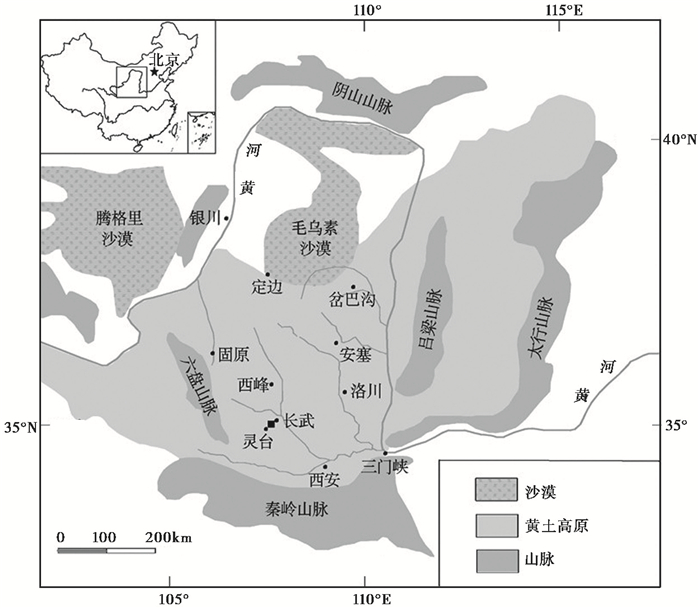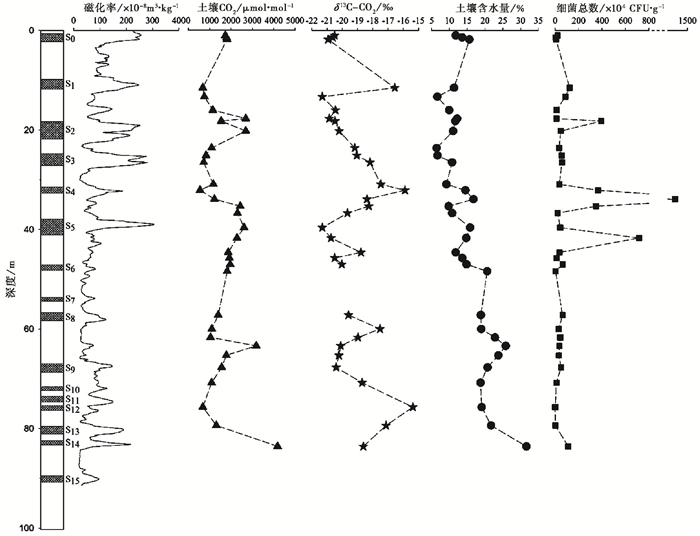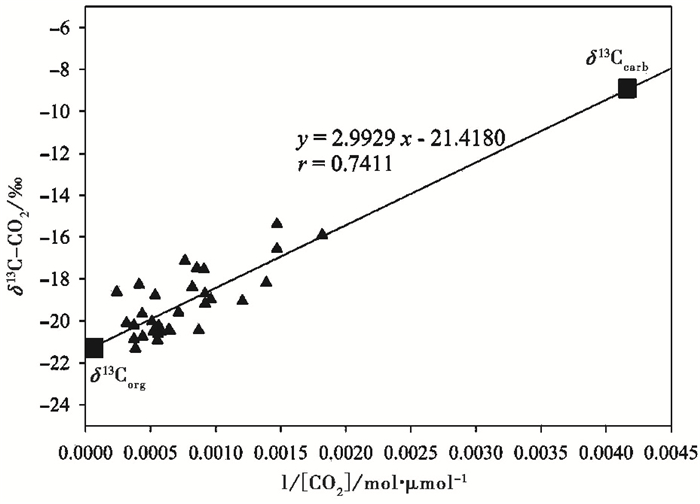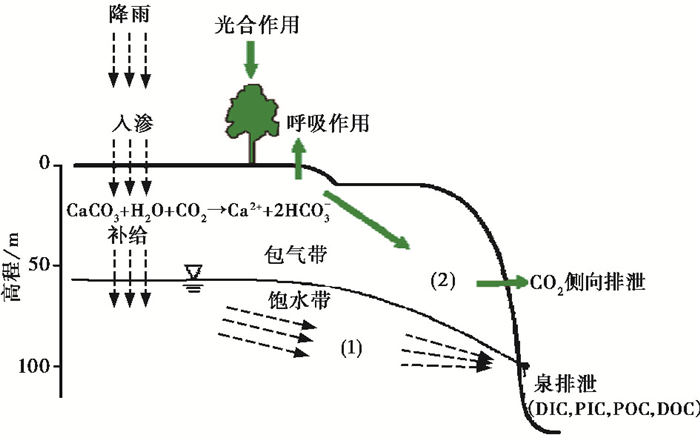② 中国地质科学院水文地质环境地质研究所, 石家庄 050061;
③ 中国科学院地理科学与资源研究所, 北京 100101)
碳循环是地球上最主要的物质循环。目前对“剩余陆地碳汇”(Residual Terrestrial Sink)还存在诸多争议[1],尤其是最复杂、最具不确定性的陆地生态系统碳循环机制认识尚不完全清楚[2]。大多数针对陆地生态系统土壤碳循环的研究主要集中在土壤表层( < 30cm)[3]。由于与大气碳库的交换不够密切且难以观测,针对深层土壤碳库的研究较少。近年来,相关研究表明,深层土壤碳库与土壤表层碳库有着较为密切的联系[3~9]。
我国北方黄土高原面积达64×104km2,典型黄土覆盖区的黄土厚度可达200m以上,与南方喀斯特地区的碳酸盐岩一样,同属巨大的碳库[10]。尽管黄土深层(>1m)土壤碳库的各种指标(如无机碳、有机碳含量或其同位素)被广泛应用于黄土古气候和古环境重建当中[11~24],积累了大量的基础数据,但我们对黄土的现代过程仍然不是十分清楚,如黄土-古土壤序列堆积以来,水(循环)、微生物等应力对黄土中各碳库及其他物质迁移转化的控制与改造作用如何等,这些问题很大程度上增加了黄土古气候定量研究的不确定性,急需进行系统深入的研究[25]。此外,研究深层黄土碳库的特征及其迁移转化过程对于土壤碳源(汇)的评估及相关减排措施的制定具有重要的意义。土壤CO2是水-土-气-生相互作用下碳循环的重要纽带,是碳酸盐矿物化学风化(岩溶作用)的驱动因子[10, 26~37],也是有机碳经微生物降解后的产物[38]。因此深入理解黄土碳库的迁移转化过程、固碳机制与潜力,黄土包气带土壤CO2是土壤深层碳循环研究中不可缺少的研究命题。
目前针对深层黄土CO2的观测研究仅有Liu等[39]利用钻杆研究了山西蒲县、偏关、兴县、离石和稷山等黄土剖面的土壤CO2含量及其同位素组成特征。其中,山西蒲县黄土剖面L1~S7土壤CO2含量在1312. 9~5945.5μmol/mol之间,古土壤中的浓度有大于相邻两个黄土层中的浓度的趋势,从上到下整体上没有太大的规律性。δ13C-CO2值范围大多在-11.14 ‰ ~-15.48 ‰ (PDB)之间。因此,Liu等[39]认为黄土中的CO2可能主要来源于稳定型有机质的微生物氧化分解,并根据CO2的δ13C值(-11.14 ‰ ~-15.48 ‰)得到碳酸盐沉淀释放对黄土CO2也有所贡献。为了进一步了解黄土包气带中CO2浓度变化特征及其内在的影响因素,笔者在甘肃省灵台县独店镇秋射村天然露头剖面开展了长期观测。在不同黄土、古土壤层位进行钻孔(水平钻进1.8m),并装设了土壤气体监测与采集装置,用于观测黄土塬区包气带(指黄土塬区地面以下潜水面以上的地带)CO2的变化特征。旨在:1)研究黄土深层碳循环机制,为黄土碳汇潜力评估提供科学依据;2)进一步认识黄土地层物质现代循环过程,为黄土古气候定量重建提供理论支撑。
2 研究方法 2.1 研究区概况本文研究的黄土剖面位于甘肃省平凉市灵台县独店镇秋射村(35°10′08.13″N,107°41′08.79″E;图 1),与陕西省长武县毗邻,距甘陕交界处仅5km。研究区为宽1.1~1.5km不等的长条形黄土残塬地貌,塬面比较完整、平坦,其海拔高度大约1240m。研究区属暖温带半湿润大陆性季风气候,年均气温9.2℃,平均降雨量605.5mm,主要集中在7月、8月和9月这3个月份,多年平均蒸发量为1415~1492mm。研究区残塬中心部位,地下水埋深56~60m,含水层厚度25m,最大涌水量为199m3/天[40];在塬区周边,由于沟谷对地下水的疏干作用,地下水埋深则在80m以上,含水层厚度也相应变薄。残塬四周沟内黄土剖面底部均有常年性泉水出露,流量约为0.45L/s[40]。本研究区的黄土泉沿黄土沟流动,汇入黑河,后汇入泾河,泾河为渭河支流。

|
图 1 研究区地理位置图(黑色方块为采样点) Fig. 1 The location map of study area(black square is sampling site) |
研究区堆积了一套典型的黄土-古土壤地层,本研究所观测的秋射剖面从表层的黑垆土(S0)到黄土L15,各黄土-古土壤层均出露于黄土沟壑中,总深度约为90m。全剖面土质较为疏松,通透性良好,有利于水分入渗和植物根系生长。研究区土地利用主要分为5类:农用地、林地、果园、草地以及难利用土地。其中一年生作物小麦、玉米根系均可伸长到2m以下,苜蓿可伸长到8m,深层分布的根系使深厚土体变成植物生长的良好的水分、养分库。
2.2 土壤CO2的野外监测用PPR管加工土壤气体集气装置(进气仓L=80cm,ϕ=45mm;导气管L=1.0m,ϕ=1cm)。进气仓用模具制作相同密度的进气孔(ϕ=6mm),并用纱窗缠绕4层以避免进气孔进土而堵塞。根据黄土-古土壤序列的厚度特征,按照每层布设一个监测装置,其中厚度较大层位增大布设密度,如L5、S5、L9等。利用手持式强力岩石电钻于2013年11月初在秋射黄土剖面预设好的位置水平打孔(孔径:45mm;孔深:1.8m),将事先加工好的PPR土壤气体采集管埋置在孔内,管口用橡皮塞封堵。测试时,连接美国生产的ATX620气体红外监测仪进行测试土壤CO2浓度([CO2]),精度为10μmol/ mol。本次研究的CO2浓度监测时间为2015年2月25日上午的9:00~11:00时。
2.3 样品采集及室内分析(1) 土壤样品采集与测试
在2013年11月进行钻孔过程中,在剖面的不同层位和深度(表 1)采集水平孔内80~160cm的混合土壤样品共33个(QS1~QS33),用密封袋密封迅速带回实验室进行相关测试。土壤含水量用烘干法测量;用灭菌的不锈钢铲采集水平孔底部(160cm)的土壤样品,装入高温灭菌的铝盒,并放入便携式冷藏箱带回实验室用标准的平板菌落计数法测试细菌总数。
| 表 1 不同黄土-古土壤序列中土壤CO2浓度及其碳同位素、土壤含水量和细菌总数 Table 1 CO2 concentration and its δ13C, soil water content, and total bacterial count in different loess and paleosol |
(2) 土壤CO2的δ13C
本研究于2015年2月25日将Tedlar气体采样袋抽真空后连接土壤中埋置的集气装置,抽取土壤气体后带回实验室进行液氮纯化,在中国科学院地球环境研究所的同位素质谱仪MAT251上进行CO2的δ13C的测定,结果表示为相对于PDB标准的千分偏差,分析误差优于± 0.2 ‰。δ13C值通过下式计算得到:

|
不同黄土(L)-古土壤(S)序列中土壤CO2浓度及其碳同位素、土壤含水量和细菌总数的结果如表 1和图 2所示。不同层位的CO2浓度有所差异,从550μmol/mol到4180μmol/mol不等(平均1664μmol/mol),包气带和饱水带界面附近的S14层位(QS33孔)的CO2浓度最高,达到了4180μmol/ mol。垂向上表现出了一定的波动。但从上到下,土壤CO2浓度的大小没有明显的规律性(图 2),也未观测到古土壤层位CO2大于相邻黄土层位CO2的趋势,这与Liu等[39]对山西蒲县黄土剖面的观测结果相类似。土壤CO2的δ13C主要集中在-21.31 ‰ ~-15.37 ‰,平均-19.25 ‰ (表 1)。在垂向上呈现较大的波动性,但未发现与黄土古土壤层位有明显的对应关系(图 2)。与Liu等[39]在山西蒲县的δ13C-CO2结果(-15.48 ‰ ~-11.14 ‰)相比,本次观测结果明显偏负。

|
图 2 土壤CO2浓度及其碳同位素、土壤含水量和细菌总数的垂向变化趋势 条带柱表示黄土-古土壤序列:白色为黄土,灰色为古土壤;磁化率数据来源于文献[41] Fig. 2 The vertical characteristics of CO2 concentration, δ13C-CO2, soil water content and total bacterial count in loess. Striped column: loess-paleosol sequences(white: loess; gray: paleosol), and the data of magnetic susceptibility is from reference [41] |
土壤含水量在6.62 % ~31.63 %之间,整体上呈现出从上到下含水量增加的趋势。S14层位的含水量最高,达31.63 %,是由于其接近泉水排泄口,故推测其位于包气带与饱水带的交界带。其次,L9层位的4个观测层位的土壤含水量较其他层位偏高,主要因为L9的黄土颗粒较粗,孔隙度较大,是黄土塬区较为重要的浅层含水层位之一[40]。
土壤细菌总数变幅较大,从1000CFU/g到1450×104CFU/g不等;S4、S5和L5等层位的细菌总数较高,其中S4高达1450×104CFU/g。
4 讨论 4.1 黄土包气带CO2的成因 4.1.1 CO2的变化特征及其可能的影响因素分析由图 2可知,古土壤S1、S3、S4、S12等层位的土壤CO2含量较低,S2、S5、S14等层位的土壤CO2含量较高;黄土层L9出现土壤CO2次高值(3180μmol/mol),其他层位的含量都较低,黄土包气带CO2在垂向上总体呈现了无规律性的波动(图 2)。而其他地区包气带土壤CO2浓度却存在一定规律:1)随深度递增:美国地质调查局阿马戈萨沙漠研究站的包气带(厚达110m)土壤CO2浓度随深度的增加而增加[42],其他很多研究成果也观察到了这种变化规律[8, 42~49]。2)双向梯度:Johnson等[50]于2008年发现巴西茹鲁埃纳山地森林生态系统酸性土壤(pH < 4.5)剖面8m以上的土壤CO2含量高达10000~90000μmol/mol。其中,0.5~3m的含量最高达80000~90000μmol/mol,5~8m含量也达到50000~60000μmol/mol。我国岩溶区的土壤CO2观测结果表明土壤CO2在垂向上呈现双向梯度,上部小,中部大,下部由于岩溶作用的吸收再次变小[27]。3)随深度递减:Hendry等[51]研究表明包气带(约5.7m)土壤CO2在夏季随深度增加而减小,冬季相反。黄土包气带土壤CO2浓度的垂向变化规律有其特殊性,其特殊性首先取决于其成因。一般情况下,表层土壤(植被影响层以上)CO2通常源自于土壤微生物呼吸作用、根际呼吸作用、土壤动物呼吸作用及含碳矿物质的化学氧化作用[52, 53],而这些作用常受土壤温度、湿度、pH、微生物和根系等因素的影响[38]。但包气带土壤CO2可能的成因主要有微生物成因[8, 42, 44, 46~49]、化学成因(碳酸盐矿物的沉淀释放)[42, 54~57]、深部地层的深穿透成因[58, 59]等。
表 1中的土壤细菌总数结果说明,土壤样品中含有大量的微生物,无论其是自养微生物还是异养微生物,都会影响土壤碳。因此,微生物活动可能是土壤CO2的一个重要控制因素。另外,本次研究S14层的CO2浓度高达4180μmol/mol,而该处正处于泉水上方,布设集气管钻孔时内部土壤呈泥泞状,土壤含水量达31.63 %。L9层位的4个观测点的土壤含水量较高,其对应的土壤CO2也相对偏高,说明其与土壤水/地下水也有关。从上述两方面看,黄土包气带CO2极为可能为两种来源:1)微生物分解土壤有机碳;2)碳酸盐矿物-CO2-H2O化学平衡体系中碳酸盐沉淀的脱气作用。
4.1.2 土壤CO2的来源及其贡献比例计算(1) 端元的确定
δ13C-CO2与1/[CO2]的线性关系图(图 3)表明δ13C-CO2与1/[CO2]呈正相关关系(y =2.9929x-21.4180;r=0.7411)。截距-21.4 ‰正好对应研究区的黄土有机碳的δ13C值(研究区毗邻区西峰剖面的δ13Corg=-23.8 ‰ ~-20.2 ‰)[60],代表有机碳的同位素端元。

|
图 3 δ13C-CO2的特征及其与土壤CO2浓度的关系 1/[CO2]为CO2浓度的倒数;δ13Ccarb是研究区地下水δ13CDIC的平均值,约取-9 ‰ [61];δ13Corg端元参考研究区毗邻地区西峰剖面的有机碳,约取-21.4 ‰ [60] Fig. 3 relationship between CO2 concentration and its δ13C-CO2: 1/[CO2]=the inverse CO2 concentration; δ13Ccarb end member is the average δ13CDIC in groundwater(approximately -9 ‰)[61]; δ13Corg end member(the δ13C of organic carbon)is determined by δ13Corg in Xifeng loess section where is nearby from this study area(approximately -21.4 ‰)[60] |
研究区地下水中δ13CDIC为-9.19 ‰ ~-8.90 ‰之间[61],因此碳酸盐沉淀脱气端元约取-9 ‰。
(2) 贡献百分比计算
由图 3可知,灵台秋射剖面土壤CO2主要来源于土壤有机碳的微生物降解,但同时也受碳酸盐风化/沉积过程的影响。图 3中的数据点越靠近δ13Corg端元,表明微生物成因的CO2越多;越靠近δ13Ccarb端元则表明受地下水中碳酸盐风化/沉淀过程的影响越大。根据δ13C-CO2组成的两端元混合法估算的微生物分解有机碳与碳酸盐沉积对土壤CO2的贡献百分比如表 2所示。结果表明,微生物降解有机碳对土壤CO2的贡献比例为40 % ~78 %,平均65 %,碳酸盐风化沉积过程对土壤CO2的贡献比例为22 % ~60 %,平均35 %。从垂向上看,有机碳的贡献递减,碳酸盐沉淀脱气作用的贡献递增。此外,随着深度的增加,土壤CO2与土壤含水量的变化基本趋于同步。这进一步说明越接近地下水,土壤的CO2与地下水的关系越密切。
| 表 2 不同黄土-古土壤序列中有机碳与碳酸盐沉淀过程对黄土CO2的贡献比例* Table 2 The contribution ratio of organic carbon and carbonate precipitation to loess CO2 according to two end member mixing model in different loess and paleosol |
不同地区包气带土壤CO2的观测结果也说明包气带土壤CO2主要与微生物降解有机碳以及地下水碳酸盐沉淀脱气有关[42, 43, 49, 62~64]。美国地质调查局多名学者通过阿马戈萨沙漠研究站包气带(厚达110m)土壤CO2及其δ13C研究表明该包气带上部的土壤CO2的成因可能主要以微生物为主,深层(尤其是地下水面附近)土壤CO2可能与碳酸盐沉淀释放有关[42]。Wood和Petraitis[48]通过δ13C-CO2以及包气带的O2浓度研究认为包气带(约36m)底部CO2浓度较大的原因是微生物降解了土壤水在入渗过程中携带的DOC所致。
4.1.3 其他影响因素土壤CO2与细菌总数的线性关系不明显(r < 0.01),表明黄土CO2与细菌总数无关,不取决于微生物的多寡,深层土壤有机碳是否容易被微生物分解生成CO2主要受限于新碳源的输入[9]。此外,我们利用宏基因组学的技术手段对黄土地下水(泉水)中微生物种群结构进行了测定,发现研究区地下水中的微生物种群极其丰富,其优势种群属于化能自养微生物,通过参加Calvin循环(Calvin于化能自养微生物Bassham)吸收CO2来满足自己所需的碳源(未发表数据)。由此可见,细菌总数的大小能否决定土壤CO2浓度主要取决与微生物种群结构及其活动特征以及可利用碳源的多寡。
尽管有研究表明,土壤CO2气体动力学机制(主要是对流与扩散)也是土壤CO2浓度的剖面分布的影响因素之一[65]。Johnson等[50]的研究也表明,在土壤水溶解下渗作用下,向下迁移的土壤CO2占呼吸作用(向上)的一半。但是黄土地层中发育的几十层古土壤层通常被认为是黄土地下水的隔水底板,致使地下水的垂向下渗速率极慢,不足以携带土壤CO2大范围的向下迁移。图 2中的土壤CO2浓度在垂向上未呈现单向递增,而是无规律的波动就是其证据之一。
4.2 对深层黄土碳库周转及黄土古气候定量化重建的启示和挑战黄土包气带土壤CO2主要来源于微生物对土壤有机碳的降解以及地下水碳酸盐矿物沉淀的脱气作用,这说明黄土深层土壤碳库在微生物活动和水循环两个应力的影响下发生着永不停歇的迁移转化,至少通过以下两种模式与大气碳库进行着碳交换(图 4):1)水循环驱动下(降雨-入渗补给-排泄)碳周转。雨水、地下水水化学研究表明在水循环驱动下黄土碳库以DIC、DOC、POC和PIC等形式持续进行碳迁移[61]。2)黄土塬边近百米深几乎垂直的千沟万壑成为黄土深层碳库向大气碳库进行侧向碳迁移重要通道之一。

|
图 4
黄土深层碳库与大气碳库的两种碳交换模式
(1)水循环驱动下(降雨-入渗补给-排泄)碳周转(黑色虚线表示);(2)CO2的侧向排泄(灰色箭头表示) DIC——溶解无机碳(dissolved inorganic carbon);PIC——颗粒无机碳(particulate inorganic carbon);POC——颗粒有机碳(particulate organic carbon);DOC——溶解有机碳(dissolved organic carbon) Fig. 4 carbon flux modes between carbon stock in depth loess and atmospheric carbon stock. (1)Carbon flux driven by water cycle: precipitation-recharge-discharge(black dashed); (2)Lateral flux of CO2(gray arrow) |
黄土古气候定量重建已成为当前该领域重点攻关的科学问题之一,但用于古气候定量重建的代用指标(如黄土有机碳及其同位素等指标)隐含的假设条件是在黄土堆积后不经过后期改造,或者其变化过程已知。任何指标在后期发生未知的细微变化都会引起古气候定量重建结果的失真。本次研究表明黄土中尤其是黄土露头剖面的碳库自黄土堆积至今一直在发生变化,目前我们对黄土堆积以来所经历的水、微生物等应力的改造过程仍然不十分掌握,这严重降低了黄土古气候重建成果的可信度。因此,亟待对黄土的现代环境过程开展系统研究,方能全面提升我国古环境定量化研究的能力。
5 结论与展望(1) 黄土剖面中土壤CO2浓度明显大于空气中的浓度,不同黄土-古土壤层位的浓度有所差异,但没有明显的规律性。包气带-饱水带界面附近S14层位的CO2浓度最高,达到了4180μmol/mol。土壤细菌总数变幅较大,从1000CFU/g到1450×104CFU/g不等;S4、S5和L5等层位的细菌总数较高,其中S4高达1450×104CFU/g。
(2) 土壤CO2的δ13C主要集中在-21.31 ‰ ~ -15.37 ‰之间,与1/[CO2]成正线性关系(r=0.7411)。表明灵台秋射剖面黄土CO2主要来源除微生物分解土壤有机碳外,也与碳酸盐矿物-H2O-CO2化学平衡体系中碳酸盐沉淀的脱气作用有关。
(3) 通过两端元混合法估算微生物降解有机碳对土壤CO2的贡献比例为40 % ~78 %,平均65 %,碳酸盐矿物沉积脱气过程对土壤CO2的贡献比例为22 % ~60 %,平均35 %。有机碳的贡献随深度递减,碳酸盐矿物沉积过程的贡献随深度递增。
(4) 黄土深层碳库内部碳库之间发生着碳的转化迁移,与大气碳库之间也存在着密切的碳迁移。
(5) 后续的研究中将会加深对黄土中物质及能量的现代迁移转化过程的研究:1)拟在塬面中心建立黄土包气带-饱水带生物地球化学观测孔,通过安装相关的原位观测及采样装置,旨在观测黄土堆积地层内部各物质与能量在水、土、气、生各介质中(及各介质之间)的迁移过程与机理;2)根据其现代过程反演黄土自堆积以来的变化过程,为古气候的定量研究提供更加详实可靠的理论依据。
致谢 感谢同行评审专家和编辑部老师提出宝贵的修改意见!
| 1 |
Liu Z, Dreybrodt W, Wang H. A new direction in effective accounting for the atmospheric CO2 budget:Considering the combined action of carbonate dissolution, the global water cycle and photosynthetic uptake of DIC by aquatic organisms. Earth-Science Reviews, 2010, 99(3~4): 162-172. |
| 2 |
方精云, 朴世龙, 赵淑清. CO2失汇与北半球中高纬度陆地生态系统的碳汇. 植物生态学报, 2001, 25(5): 594-602. Fang Jingyun, Piao Shilong, Zhao Shuqing. The carbon sink:The role of the middle and high latitudes terrestrial ecosystem in the Northern Hemisphere. Acta Phytoecologica Sinica, 2001, 25(5): 594-602. |
| 3 |
Chaopricha N T, Marín-Spiotta E. Soil burial contributes to deep soil organic carbon storage. Soil Biology and Biochemistry, 2014, 69(69): 251-264. |
| 4 |
Harper R J, Tibbett M. The hidden organic carbon in deep mineral soils. Plant and Soil, 2013, 368(1~2): 641-648. |
| 5 |
Harrison R B, Footen P W, Strahm B D. Deep soil horizons:Contribution and importance to soil carbon pools and in assessing whole-ecosystem response to management and global change. Forest Science, 2011, 57(1): 67-76. |
| 6 |
Devine S, Markewitz D, Hendrix P et al. Soil carbon change through 2m during forest succession alongside a 30-year agroecosystem experiment. Forest Science, 2011, 57(1): 36-50. |
| 7 |
Veldkamp E, Becker A, Schwendenmann L et al. Substantial labile carbon stocks and microbial activity in deeply weathered soils below a tropical wet forest. Global Change Biology, 2003, 9(8): 1171-1184. DOI:10.1046/j.1365-2486.2003.00656.x |
| 8 |
Davidson E, Lefebvre P A, Brando P M et al. Carbon inputs and water uptake in deep soils of an eastern Amazon forest. Forest Science, 2011, 57(1): 51-58. |
| 9 |
Rumpel C, K gel-Knabner I. Deep soil organic matter--A key but poorly understood component of terrestrial C cycle. Plant and Soil, 2011, 338(1~2): 143-158. |
| 10 |
万国江, 王仕禄. 我国南方岩溶区和北方黄土区的大气CO2效应. 第四纪研究, 2000, 20(4): 305-315. Wan Guojiang, Wang Shilu. Effects of the atmospheric CO2 in karst area of Sourthern and loess area of Northern China. Quaternary Sciences, 2000, 20(4): 305-315. |
| 11 |
张虎才, 张林源, 张维信. 兰州九州台黄土剖面--碳氧同位素及黄土沉积环境研究. 兰州大学学报(自然科学版), 1990, 26(8): 117-126. Zhang Hucai, Zhang Linyuan, Zhang Weixin. Studies on carbon and oxygen isotopic geochemical characteristics and loess sedimentation of Jiuzhoutai loess profile, Lanzhou. Journal of Lanzhou University (Natural Sciences), 1990, 26(8): 117-126. |
| 12 |
顾兆炎. 黄土-古土壤序列碳酸盐同位素组成与古气候变化. 科学通报, 1991, 36(10): 767-770. Gu Zhaoyan. The carbonate isotopic composition of the loess-paleosol sequence and its implication of paleoclimate change. Chinese Science Bulletin, 1991, 36(10): 767-770. |
| 13 |
陈明扬, 赵惠敏. 7.3~1.9Ma期间中国黄土高原碳同位素记录与古季风气候. 科学通报, 1997, 42(2): 174-177. Chen Mingyang, Zhao Huimin. Carbon isotope records and paleo-monsoon climate in China Loess Plateau during period of 7.3~1.9Ma. Chinese Science Bulletin, 1997, 42(2): 174-177. |
| 14 |
刘丛强, 张劲, 李春来. 黄土中CaCO3含量及其Sr同位素组成变化与古气候波动记录. 科学通报, 1999, 44(10): 1088-1092. Liu Congqiang, Zhang Jin, Li Chunlai. Variations in CaCO3 content and Sr isotopic composition of loess and records of paleoclimatic fluctuations. Chinese Science Bulletin, 1999, 44(10): 1088-1092. DOI:10.3321/j.issn:0023-074X.1999.10.016 |
| 15 |
曹军骥, 王亚强, 张小曳等. 大气中碳酸盐的碳同位素分析及其来源指示意义. 科学通报, 2004, 49(17): 1785-1788. Cao Junji, Wang Yaqiang, Zhang Xiaoye et al. Carbon isotope analysis of carbonate in atmosphere and its implication to source. Chinese Science Bulletin, 2004, 49(17): 1785-1788. DOI:10.3321/j.issn:0023-074X.2004.17.016 |
| 16 |
An Zhisheng, Huang Yongsong, Liu Weiguo et al. Multiple expansions of C4 plant biomass in East Asia since 7Ma coupled with strengthened monsoon circulation. Geology, 2005, 33(9): 705-708. DOI:10.1130/G21423.1 |
| 17 |
张普, 刘卫国, 周卫健等. 黄土塬竖井剖面黄土-古土壤碳同位素记录特征. 地球化学, 2008, 37(5): 423-429. Zhang Pu, Liu Weiguo, Zhou Weijian et al. Carbon isotope characteristics of loess-paleosol sequences derived from phreatic section on Chinese Loess Plateau. Geochimica, 2008, 37(5): 423-429. |
| 18 |
张普, 刘卫国. 黄土高原中部黄土沉积有机质记录特征及C/N指示意义. 海洋地质与第四纪地质, 2009, 28(6): 119-124. Zhang Pu, Liu Weiguo. Loess sedimentary organic matter records from the central Chinese Loess Plateau and the implication of C/N. Marine Geology & Quaternary Geology, 2009, 28(6): 119-124. |
| 19 |
秦小光, 宁波, 殷志强等. 末次间冰期以来渭南黄土地区土壤有机碳碳库的演变. 地球科学--中国地质大学学报, 2011, 36(2): 386-392. Qin Xiaoguang, Ning Bo, Yin Zhiqiang et al. Evolution of soil organic carbon pool in Weinan loess region since the last interglacial period. Earth Science--Journal of China University of Geoscience, 2011, 36(2): 386-392. |
| 20 |
杜青松. 黄土高原黄土-古土壤序列古气候代用指标综述. 西北地质, 2011, 44(2): 177-185. Du Qingsong. Research on loess-paleosol sequence paleoclimate proxies in Loess Plateau. Northwestern Geology, 2011, 44(2): 177-185. |
| 21 |
何同, 刘连文, 陈旸等. 晚中新世-上新世黄土高原佳县红粘土剖面碳同位素记录与C4植被演化. 第四纪研究, 2015, 35(4): 791-800. He Tong, Liu Lianwen, Chen Yang et al. Carbon isotope record of authigenic calcite from the northern Chinese Loess Plateau:Implications for C4 vegetation evolution during Late Miocene Pliocene. Quaternary Sciences, 2015, 35(4): 791-800. |
| 22 |
张红艳, 鹿化煜, 顾兆炎等. 中国半干旱-湿润区末次间冰期以来黄土有机碳同位素特征与植被变化. 第四纪研究, 2015, 35(4): 809-818. Zhang Hongyan, Lu Huayu, Gu Zhaoyan et al. Organic matter stable isotopic composition of loess deposits in semiarid to humid climate regions of China and the vegetation variations since the last interglaciation. Quaternary Sciences, 2015, 35(4): 809-818. |
| 23 |
鹿化煜, 张红艳, 曾琳等. 温度影响东北地区更新世植被变化的黄土记录. 第四纪研究, 2015, 35(4): 828-836. Lu Huayu, Zhang Hongyan, Zeng Lin et al. Temperature forced vegetation variations in glacial interglacial cycles in Northeastern China revealed by loess paleosol deposit. Quaternary Sciences, 2015, 35(4): 828-836. |
| 24 |
饶志国, 郭文康, 薛骞等. 黄土高原西部地区黄土地层有机质主要来源分析. 第四纪研究, 2015, 35(4): 819-827. Rao Zhiguo, Guo Wenkang, Xue Qian et al. Assessment on primary provenance of organic matter in loess/paleosol sequences in the western Chinese Loess Plateau:Local biomass or bedrocks in dust source regions?. Quaternary Sciences, 2015, 35(4): 819-827. |
| 25 |
郭正堂, 羊向东, 陈发虎等. 末次冰盛期以来我国气候环境变化及人类适应. 科学通报, 2014, 59(30): 2937-2939. Guo Zhengtang, Yang Xiangdong, Chen Fahu et al. Climate change in China since the Last Glacial Maximum and Holocene human adaptation. Chinese Science Bulletin, 2014, 59(30): 2937-2939. |
| 26 |
刘再华, Wolfgang Dreybrodt. 岩溶作用动力学与环境. 北京: 地质出版社, 2007, 1-236. Liu Zai-hua, Wolfgang Dreybrodt. Karst Dynamics and Environment. Beijing: Geological Publishing House, 2007, 1-236. |
| 27 |
袁道先. 中国岩溶动力学系统. 北京: 地质出版社, 2002, 1-275. Yuan Daoxian. Karst Dynamic System of China. Beijing: Geological Publishing House, 2002, 1-275. |
| 28 |
刘再华, 何师意, 袁道先等. 土壤中的CO2及其对岩溶作用的驱动. 水文地质工程地质, 1998, 25(4): 42-45. Liu Zaihua, He Shiyi, Yuan Daoxian et al. The CO2 regime of soil profile and its drive to dissolution. Hydrogeology & Engineering Geology, 1998, 25(4): 42-45. |
| 29 |
何师意, 徐胜友, 张美良. 岩溶土壤中CO2浓度、水化学观测及其与岩溶作用关系. 中国岩溶, 1997, 16(4): 319-324. He Shiyi, Xu Shengyou, Zhang Meiliang. Observation on soil CO2 concentration, hydrochemistry, and their relationship with karst processes. Carsologica Sinica, 1997, 16(4): 319-324. |
| 30 |
徐胜友, 何师意. 碳酸盐岩土壤CO2的动态特征及其对溶蚀作用的驱动. 中国岩溶, 1996, 15(Z1): 50-57. Xu Shengyou, He Shiyi. The CO2 regime of soil profile and its drive to dissolution of carbonate rock. Carsologica Sinica, 1996, 15(Z1): 50-57. |
| 31 |
唐灿, 周平根. 北京典型溶洞土壤中的CO2及其对岩溶作用的驱动. 中国岩溶, 1999, 18(3): 213-217. Tang Can, Zhou Pinggen. The soil CO2 and its driving action on karstification in typical karst area in Beijing. Carsologica Sinica, 1999, 18(3): 213-217. |
| 32 |
Cao J, Yuan D, Chris G et al. Carbon fluxes and sinks:The consumption of atmospheric and soil CO2 by carbonate rock dissolution. Acta Geologica Sinica (English Edition), 2012, 86(4): 963-972. DOI:10.1111/j.1755-6724.2012.00720.x |
| 33 |
袁道先. 地球系统的碳循环与资源环境效应. 第四纪研究, 2001, 21(3): 223-232. Yuan Daoxian. Carbon cycle in Earth system its effects on environment and resources. Quaternary Sciences, 2001, 21(3): 223-232. |
| 34 |
莫雪, 蒲俊兵, 袁道先等. 亚热带典型岩溶区地表溪流溶解无机碳昼夜变化特征及其影响因素. 第四纪研究, 2014, 34(4): 873-880. Mo Xue, Pu Junbing, Yuan Daoxian et al. Diel variation and influence factors of dissolved inorganic carbon in a surface creek fed by a karst subterranean stream in subtropical area, SW China. Quaternary Sciences, 2014, 34(4): 873-880. |
| 35 |
章程, Mahippong Worakul, 汪进良等. 泰国热带典型岩溶峰丛谷地区不同土地利用土下的溶蚀速率. 第四纪研究, 2016, 36(6): 1393-1402. Zhang Cheng, Mahippong Worakul, Wang Jinliang et al. Dissolution rates in soil of different landuses of typical tropical karst peak depression valley in Thailand. Quaternary Sciences, 2016, 36(6): 1393-1402. |
| 36 |
李玲珑, 刘再华. 不同植被条件下岩溶地下水δ13CDIC的差异研究--以贵州夜郎洞、天钟洞和普定岩溶水碳通量模拟试验场为例. 第四纪研究, 2015, 35(4): 913-921. Li Linglong, Liu Zaihua. Study on the difference in δ13CDIC of karst groundwater under different conditions of vegetation--Examples from Yelang Cave, Tianzhong Cave and Puding Simulation Test Site. Quaternary Sciences, 2015, 35(4): 913-921. |
| 37 |
黄奇波, 覃小群, 刘朋雨等. 人为活动对乌江中上游段岩溶地下水δ13CDIC及碳汇效应的影响. 第四纪研究, 2016, 36(6): 1358-1369. Huang Qibo, Qin Xiaoqun, Liu Pengyu et al. The impact of human activities to δ13CDIC of karst groundwater and carbon sink in the upper and middle reaches of Wujiang River. Quaternary Sciences, 2016, 36(6): 1358-1369. |
| 38 |
王超, 杨智杰, 陈光水等. 土壤垂直剖面的CO2通量研究. 亚热带资源与环境学报, 2011, 5(4): 85-92. Wang Chao, Yang Zhijie, Chen Guangshui et al. Research on the flux of carbon dioxide in soil vertical profile. Journal of Subtropical Resources and Environment, 2011, 5(4): 85-92. |
| 39 |
Liu Qiang, Liu Jiaqi, Sui Shuzhen. Features of major greenhouse gases in loess, Shanxi Province, China. Chinese Science Bulletin, 2001, 2001, 46(17): 1469-1471. |
| 40 |
甘肃省地质局水文一队. 甘肃省泾川、灵台、崇信三县农田供水水文地质勘查报告. 1981 The First Party of Hydrogeology. Gansu Bureau of Geology and Mineral Exploration and Development. Report of Hydrogeological Exploration for Irrigation in Jingchuan, Lingtai, Chongxin County of Gansu Province. 1981 |
| 41 |
Sun Y, Clemens S C, An Z et al. Astronomical timescale and palaeoclimatic implication of stacked 3.6-Myr monsoon records from the Chinese Loess Plateau. Quaternary Science Reviews, 2006, 25(1): 33-48. |
| 42 |
Walvoord M A, Striegl R G, Prudic D E et al. CO2 dynamics in the Amargosa Desert:Fluxes and isotopic speciation in a deep unsaturated zone. Water Resources Research, 2005, 41(2): W2006. |
| 43 |
Arora B, Spycher N F, Steefel C I et al. Influence of hydrological, biogeochemical and temperature transients on subsurface carbon fluxes in a flood plain environment. Biogeochemistry, 2016, 127(2~3): 367-396. |
| 44 |
Benavente J, Vadillo I, Carrasco F et al. Air carbon dioxide contents in the vadose zone of a Mediterranean karst. Vadose Zone Journal, 2010, 9(1): 126-136. DOI:10.2136/vzj2009.0027 |
| 45 |
Conrad M E, Arora B, Williams K H et al. Using Concentrations and Isotopic Compositions of CO2 to Distinguish Microbial Production of CO2 in Unsaturated Zone Sediments in Hydrogeochemical Models. In:AGU Fall Meeting Abstracts, 2014
|
| 46 |
Keller C K. Hydrogeochemistry of a clayey till:2. Sources of CO2. Water Resources Research, 1991, 27(10): 2555-2564. DOI:10.1029/91WR01587 |
| 47 |
Wood B D, Keller C K, Johnstone D L. In situ measurement of microbial activity and controls on microbial CO2 production in the unsaturated zone. Water Resources Research, 1993, 29(3): 647-659. DOI:10.1029/92WR02315 |
| 48 |
Wood W W, Petraitis M J. Origin and distribution of carbon dioxide in the unsaturated zone of the southern high plains of Texas. Water Resources Research, 1984, 20(9): 1193-1208. DOI:10.1029/WR020i009p01193 |
| 49 |
Reardon E J, Allison G B, Fritz P. Seasonal chemical and isotopic variations of soil CO2 at Trout Creek, Ontario. Journal of Hydrology, 1979, 43(1): 355-371. |
| 50 |
Johnson M S, Lehmann J, Riha S J et al. CO2 efflux from Amazonian headwater streams represents a significant fate for deep soil respiration. Geophysical Research Letters, 2008, 35(L17401): 1-5. |
| 51 |
Hendry M J, Mendoza C A, Kirkland R A et al. Quantification of transient CO2 production in a sandy unsaturated zone. Water Resources Research, 1999, 35(7): 2189-2198. DOI:10.1029/1999WR900060 |
| 52 |
Hanson P J, Edwards N T, Garten C T et al. Separating root and soil microbial contributions to soil respiration:A review of methods and observations. Biogeochemistry, 2000, 48(1): 115-146. DOI:10.1023/A:1006244819642 |
| 53 |
Reardon E J, Allison G B, Fritz P. Seasonal chemical and isotopic variations of soil CO2, at Trout Creek, Ontario. Journal of Hydrology, 1979, 43(1): 355-371. |
| 54 |
Tamir G, Shenker M, Heller H et al. Can soil carbonate dissolution lead to overestimation of soil respiration?. Soil Science Society of America Journal, 2011, 75(4): 1414-1422. DOI:10.2136/sssaj2010.0396 |
| 55 |
Tamir G, Shenker M, Heller H et al. Dissolution and re-crystallization processes of active calcium carbonate in soil developed on tufa. Soil Science Society of America Journal, 2012, 76(5): 1606-1613. DOI:10.2136/sssaj2012.0041 |
| 56 |
Gong W, Yan X, Wang J. The effect of chemical fertilizer on soil organic carbon renewal and CO2 emission--A pot experiment with maize. Plant and Soil, 2012, 353(1~2): 85-94. |
| 57 |
Ramnarine R, Wagner-Riddle C, Dunfield K E et al. Contributions of carbonates to soil CO2 emissions. Canadian Journal of Soil Science, 2012, 92(4): 599-607. DOI:10.4141/cjss2011-025 |
| 58 |
王学求. 深穿透地球化学迁移模型. 地质通报, 2005, 24(10~11): 892-896. Wang Xueqiu. Conceptual model for deep-penetrating geochemical migration. Geological Bulletin of China, 2005, 24(10~11): 892-896. |
| 59 |
谢学锦, 王学求. 深穿透地球化学新进展. 地学前缘, 2003, 10(1): 225-238. Xie Xuejin, Wang Xueqiu. New progress on deep-penetrating geochemistry. Earth Science Frontiers, 2003, 10(1): 225-238. |
| 60 |
宁有丰, 刘卫国, 安芷生. 甘肃西峰黄土-古土壤剖面的碳酸盐与有机碳的碳同位素差值(Δδ13C)的变化及其古环境意义. 科学通报, 2006, 51(15): 1828-1832. Ning Youfeng, Liu Weiguo, An Zhisheng. Variation of soil Δδ13C values in Xifeng loess-paleosol sequence and its paleo-environmental implication. Chinese Science Bulletin, 2006, 51(15): 1828-1832. DOI:10.3321/j.issn:0023-074X.2006.15.015 |
| 61 |
宋超, 王攀, 韩贵琳等. 黄土塬区浅层地下水化学特征及其碳循环意义. 南水北调与水利科技, 2017, 15(5): 121-126. Song Chao, Wang Pan, Han Guilin et al. The hydro-chemical characteristics of shallow groundwater in loess tableland and its implication to carbon cycle. South-to-North Water Transfers and Water Science & Technology, 2017, 15(5): 121-126. |
| 62 |
Suchomel K H, Kreamer D K, Long A. Production and transport of carbon dioxide in a contaminated vadose zone:A stable and radioactive carbon isotope study. Environmental Science & Technology, 1990, 24(12): 1824-1831. |
| 63 |
Keller C K, Bacon D H. Soil respiration and georespiration distinguished by transport analyses of vadose CO2, 13CO2, and 14CO2. Global Biogeochemical Cycles, 1998, 12(2): 361-372. DOI:10.1029/98GB00742 |
| 64 |
Thorstenson D C, Weeks E P, Haas H et al. Chemistry of unsaturated zone gases sampled in open boreholes at the crest of Yucca Mountain, Nevada:Data and basic concepts of chemical and physical processes in the mountain. Water Resources Research, 1998, 34(6): 1507-1529. DOI:10.1029/98WR00267 |
| 65 |
Hashimoto S, Komatsu H. Relationships between soil CO2 concentration and CO2 production, temperature, water content, and gas diffusivity:Implications for field studies through sensitivity analyses. Journal of Forest Research, 2006, 11(1): 41-50. DOI:10.1007/s10310-005-0185-4 |
② Institute of Hydrogeology and Environmental Geology, Chinese Academy of Geological Sciences, Shijiazhuang 050061;
③ Institute of Geographic Sciences and Natural Resources Research, Chinese Academy of Sciences, Beijing 100101)
Abstract
The Chinese Loess Plateau, with an area of 640000km2 and a thickness up to 200m, is regarded as a huge carbon sink in China. However, the modern carbon cycle in deep loess is still not well understood. Soil CO2 as a key factor for the carbon cycle of deep loess has been inadequately studied and reported. In order to observe the CO2 characteristics and origin in unsaturated zone at loess tableland and further understand carbon cycle in deep loess, a series of tubes for gas monitoring and sampling were installed into horizontal boreholes in Qiushe loess section(35°10'08.13″N, 107°41'08.79″E) of Lingtai County, Northwestern China, where develops a set of typical loess-paleosol sequences. The soil samples were collected when drilling the holes and their water content and total bacterial count were measured, and the concentration of loess CO2 and their δ13C were determined. The observed results show that the soil water content varied from 6.62% to 31.63%, displaying a increasing trend with depth, while the total bacterial count had a large range from 1000CFU/g to 1450×104CFU/g with no distinct trend along depth. The CO2 concentration in loess is higher than in atmosphere and reaches the maximum of 4180μmol/mol in S14, and different loess/paleosol fails to display an instinct trend. The δ13C value of CO2 ranged from -21.31‰ to -15.37‰, and had a positive relationship with 1/[CO2](r=0.7411). The results showed that CO2 in loess is not only relative to decomposed organic carbon by microbe, and also to the degassing effect in the balance system among CaCO3-H2O-CO2 in the interface between saturated and unsaturated zone. According to the two end member mixing model, the contribution ratios of organic carbon and carbonate precipitation to loess CO2 were calculated. As the result, the contribution ratios of organic carbon to loess CO2 is up to 40%~78%(average 65%)and have a decreasing trend with depth, while the contribution of carbonate precipitation is 22%~60%(average 35%), increasing with depth. These carbon fluxes of deep loess carbon stock such as transportation and transformation is posing a new challenge on the study of the quantitative paleoclimate reconstruction using some proxies related to carbon in loess. The modern processes on matter and energy cycle in deep loess need to be re-explored so as to advance the study on paleoclimate records in loess. 2017, Vol.37
2017, Vol.37

